Taxation Law Report: Analysis of Arthur Murray and RIP Pty Ltd Cases
VerifiedAdded on 2021/06/17
|12
|3464
|47
Report
AI Summary
This report provides a detailed analysis of taxation law, specifically examining the case of Arthur Murray (NSW) Pty Ltd v FCT and a scenario involving RIP Pty Ltd. The report delves into key issues such as the treatment of prepaid fees as assessable income, the application of the ITAA 1997, and the distinction between the earning and receipt methods of accounting. It explores the court's decision in Arthur Murray, which determined that prepaid fees for dance classes were not taxable income at the time of receipt if refunds were possible. Furthermore, the report analyzes the implications of prepaid fees for RIP Pty Ltd, considering whether forfeited fees constitute taxable income. The report also discusses trading stock, capital assets, and relevant tax deductions. It references taxation rulings and legislation to support its arguments, offering a comprehensive understanding of the complexities of taxation law in relation to service-based businesses.
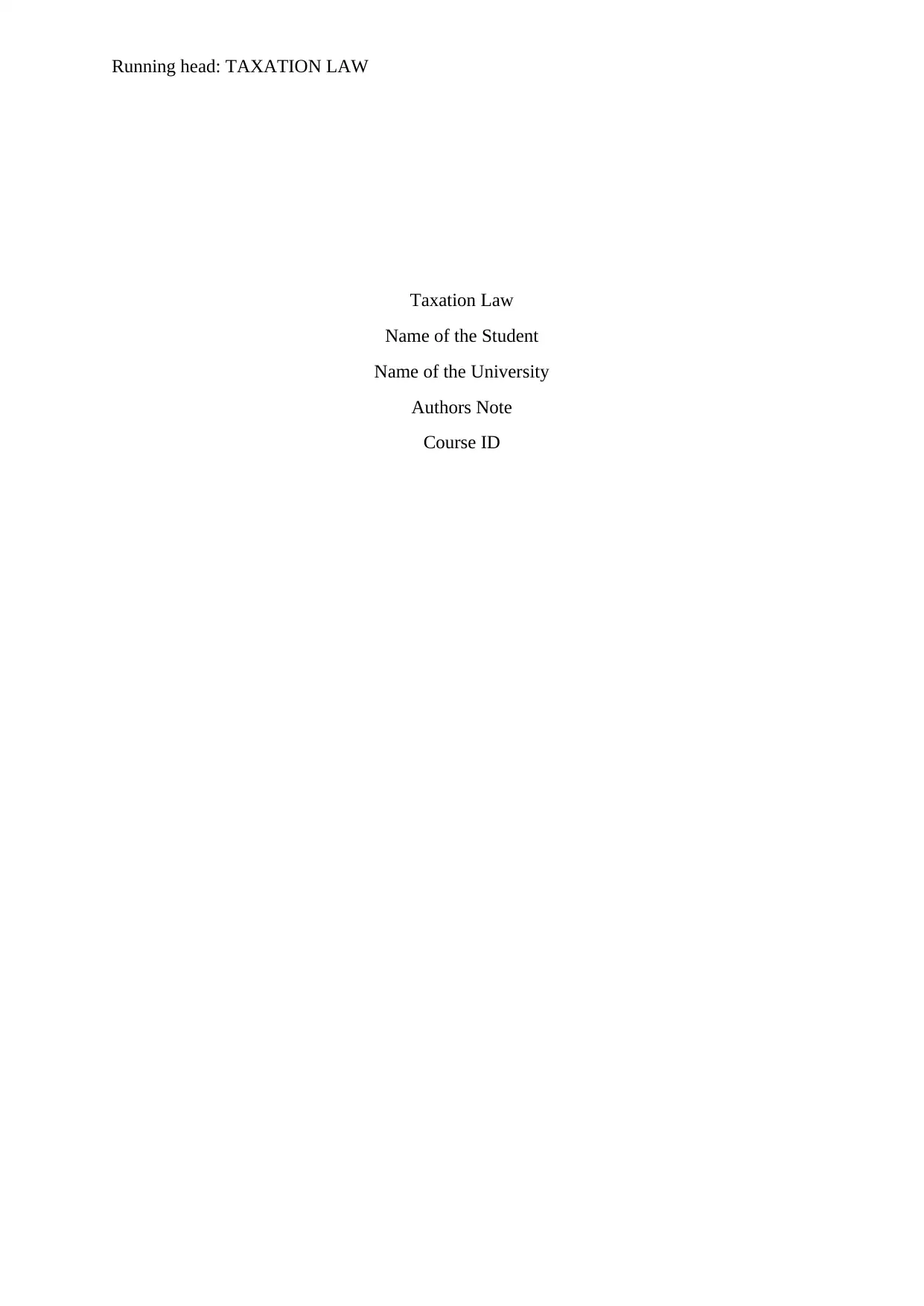
Running head: TAXATION LAW
Taxation Law
Name of the Student
Name of the University
Authors Note
Course ID
Taxation Law
Name of the Student
Name of the University
Authors Note
Course ID
Paraphrase This Document
Need a fresh take? Get an instant paraphrase of this document with our AI Paraphraser
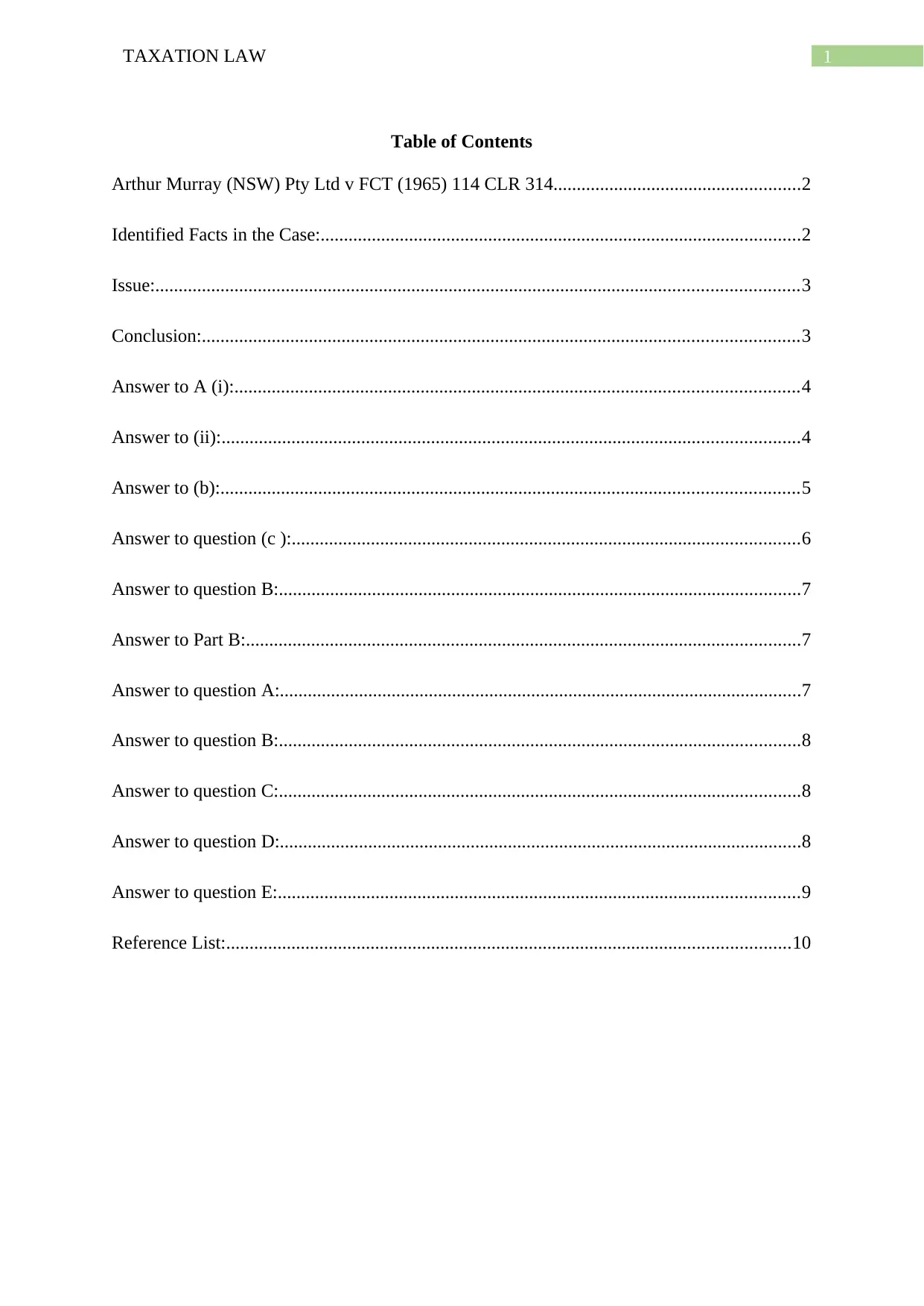
1TAXATION LAW
Table of Contents
Arthur Murray (NSW) Pty Ltd v FCT (1965) 114 CLR 314.....................................................2
Identified Facts in the Case:.......................................................................................................2
Issue:..........................................................................................................................................3
Conclusion:................................................................................................................................3
Answer to A (i):.........................................................................................................................4
Answer to (ii):............................................................................................................................4
Answer to (b):............................................................................................................................5
Answer to question (c ):.............................................................................................................6
Answer to question B:................................................................................................................7
Answer to Part B:.......................................................................................................................7
Answer to question A:................................................................................................................7
Answer to question B:................................................................................................................8
Answer to question C:................................................................................................................8
Answer to question D:................................................................................................................8
Answer to question E:................................................................................................................9
Reference List:.........................................................................................................................10
Table of Contents
Arthur Murray (NSW) Pty Ltd v FCT (1965) 114 CLR 314.....................................................2
Identified Facts in the Case:.......................................................................................................2
Issue:..........................................................................................................................................3
Conclusion:................................................................................................................................3
Answer to A (i):.........................................................................................................................4
Answer to (ii):............................................................................................................................4
Answer to (b):............................................................................................................................5
Answer to question (c ):.............................................................................................................6
Answer to question B:................................................................................................................7
Answer to Part B:.......................................................................................................................7
Answer to question A:................................................................................................................7
Answer to question B:................................................................................................................8
Answer to question C:................................................................................................................8
Answer to question D:................................................................................................................8
Answer to question E:................................................................................................................9
Reference List:.........................................................................................................................10
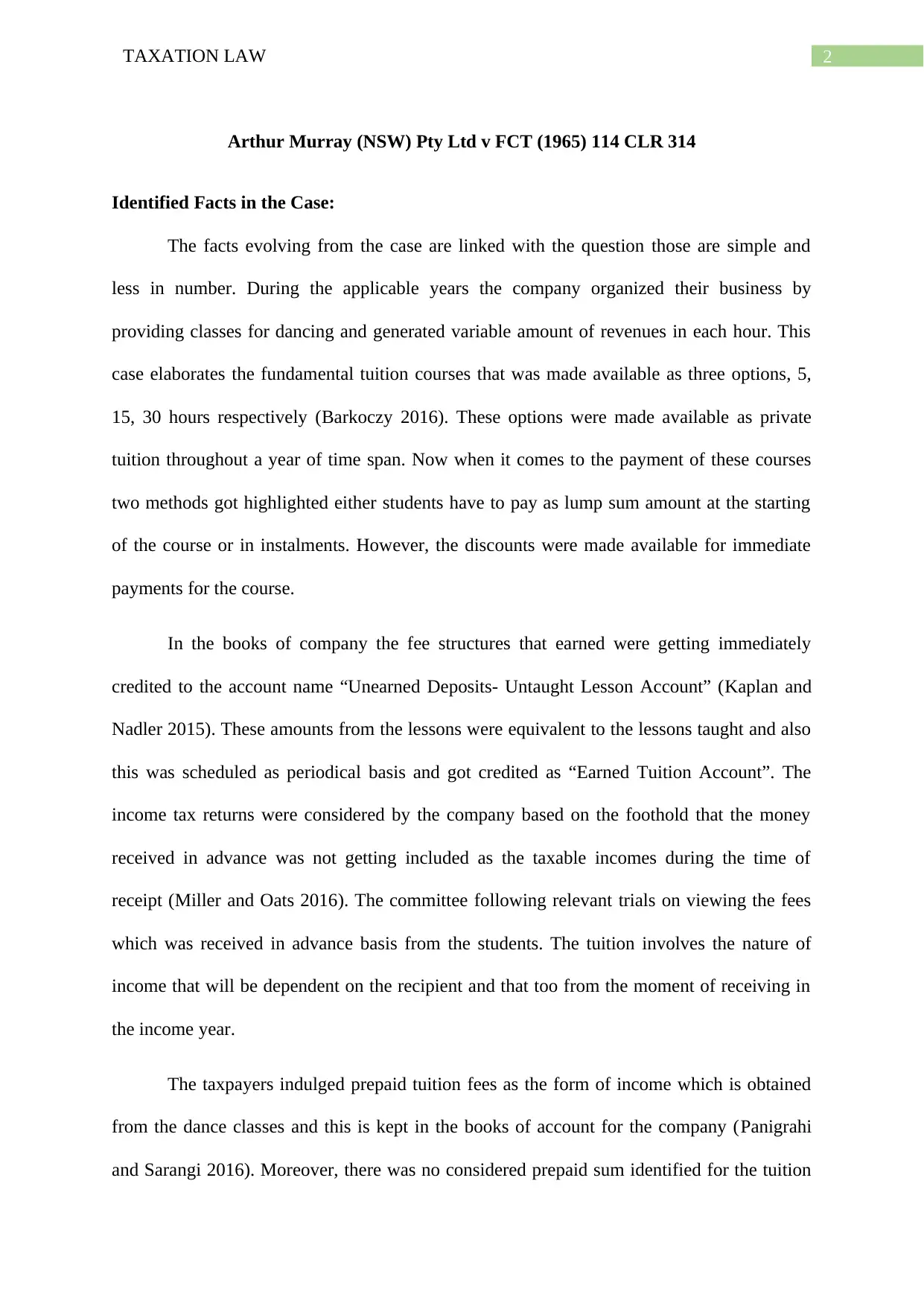
2TAXATION LAW
Arthur Murray (NSW) Pty Ltd v FCT (1965) 114 CLR 314
Identified Facts in the Case:
The facts evolving from the case are linked with the question those are simple and
less in number. During the applicable years the company organized their business by
providing classes for dancing and generated variable amount of revenues in each hour. This
case elaborates the fundamental tuition courses that was made available as three options, 5,
15, 30 hours respectively (Barkoczy 2016). These options were made available as private
tuition throughout a year of time span. Now when it comes to the payment of these courses
two methods got highlighted either students have to pay as lump sum amount at the starting
of the course or in instalments. However, the discounts were made available for immediate
payments for the course.
In the books of company the fee structures that earned were getting immediately
credited to the account name “Unearned Deposits- Untaught Lesson Account” (Kaplan and
Nadler 2015). These amounts from the lessons were equivalent to the lessons taught and also
this was scheduled as periodical basis and got credited as “Earned Tuition Account”. The
income tax returns were considered by the company based on the foothold that the money
received in advance was not getting included as the taxable incomes during the time of
receipt (Miller and Oats 2016). The committee following relevant trials on viewing the fees
which was received in advance basis from the students. The tuition involves the nature of
income that will be dependent on the recipient and that too from the moment of receiving in
the income year.
The taxpayers indulged prepaid tuition fees as the form of income which is obtained
from the dance classes and this is kept in the books of account for the company (Panigrahi
and Sarangi 2016). Moreover, there was no considered prepaid sum identified for the tuition
Arthur Murray (NSW) Pty Ltd v FCT (1965) 114 CLR 314
Identified Facts in the Case:
The facts evolving from the case are linked with the question those are simple and
less in number. During the applicable years the company organized their business by
providing classes for dancing and generated variable amount of revenues in each hour. This
case elaborates the fundamental tuition courses that was made available as three options, 5,
15, 30 hours respectively (Barkoczy 2016). These options were made available as private
tuition throughout a year of time span. Now when it comes to the payment of these courses
two methods got highlighted either students have to pay as lump sum amount at the starting
of the course or in instalments. However, the discounts were made available for immediate
payments for the course.
In the books of company the fee structures that earned were getting immediately
credited to the account name “Unearned Deposits- Untaught Lesson Account” (Kaplan and
Nadler 2015). These amounts from the lessons were equivalent to the lessons taught and also
this was scheduled as periodical basis and got credited as “Earned Tuition Account”. The
income tax returns were considered by the company based on the foothold that the money
received in advance was not getting included as the taxable incomes during the time of
receipt (Miller and Oats 2016). The committee following relevant trials on viewing the fees
which was received in advance basis from the students. The tuition involves the nature of
income that will be dependent on the recipient and that too from the moment of receiving in
the income year.
The taxpayers indulged prepaid tuition fees as the form of income which is obtained
from the dance classes and this is kept in the books of account for the company (Panigrahi
and Sarangi 2016). Moreover, there was no considered prepaid sum identified for the tuition
⊘ This is a preview!⊘
Do you want full access?
Subscribe today to unlock all pages.

Trusted by 1+ million students worldwide
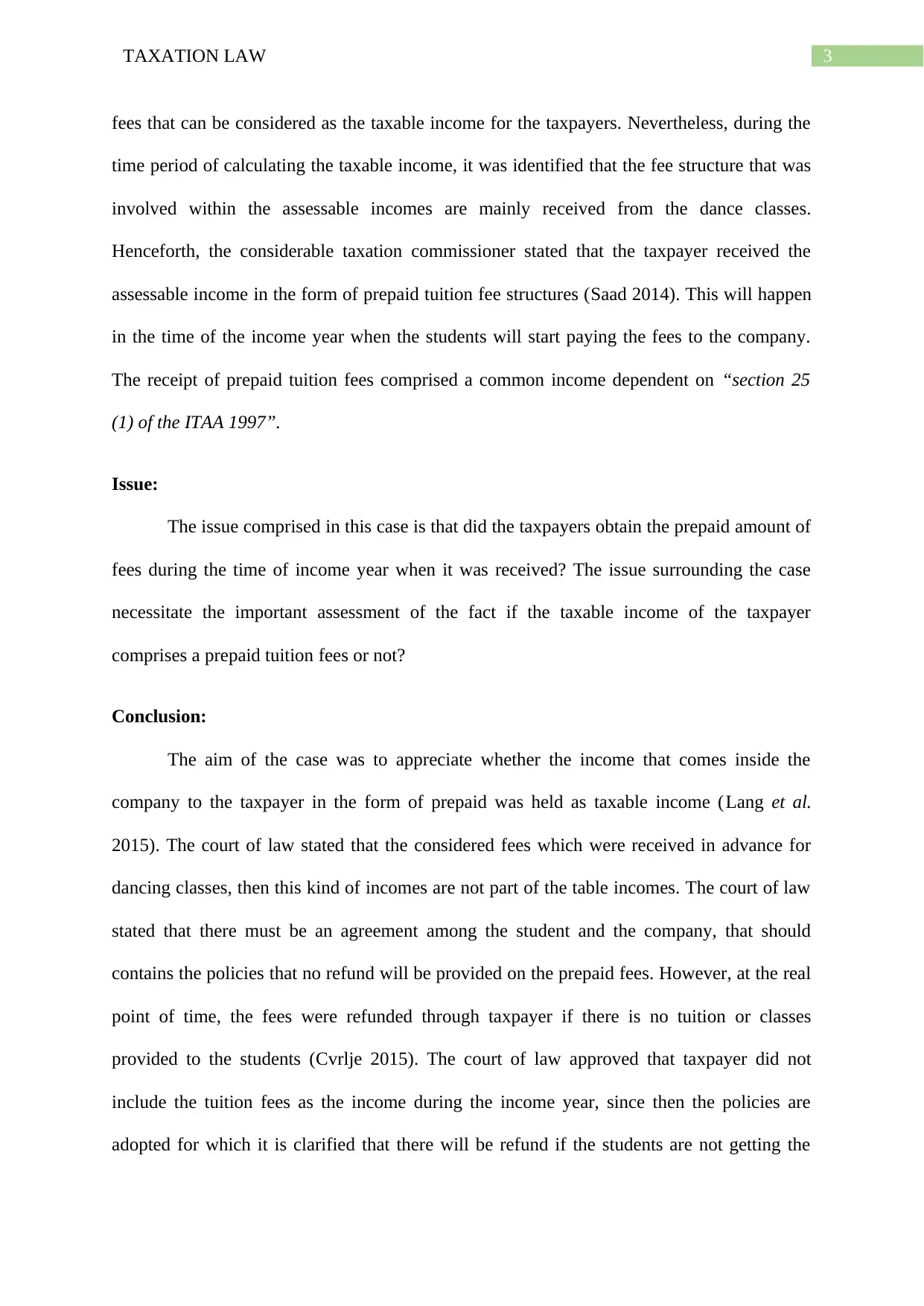
3TAXATION LAW
fees that can be considered as the taxable income for the taxpayers. Nevertheless, during the
time period of calculating the taxable income, it was identified that the fee structure that was
involved within the assessable incomes are mainly received from the dance classes.
Henceforth, the considerable taxation commissioner stated that the taxpayer received the
assessable income in the form of prepaid tuition fee structures (Saad 2014). This will happen
in the time of the income year when the students will start paying the fees to the company.
The receipt of prepaid tuition fees comprised a common income dependent on “section 25
(1) of the ITAA 1997”.
Issue:
The issue comprised in this case is that did the taxpayers obtain the prepaid amount of
fees during the time of income year when it was received? The issue surrounding the case
necessitate the important assessment of the fact if the taxable income of the taxpayer
comprises a prepaid tuition fees or not?
Conclusion:
The aim of the case was to appreciate whether the income that comes inside the
company to the taxpayer in the form of prepaid was held as taxable income (Lang et al.
2015). The court of law stated that the considered fees which were received in advance for
dancing classes, then this kind of incomes are not part of the table incomes. The court of law
stated that there must be an agreement among the student and the company, that should
contains the policies that no refund will be provided on the prepaid fees. However, at the real
point of time, the fees were refunded through taxpayer if there is no tuition or classes
provided to the students (Cvrlje 2015). The court of law approved that taxpayer did not
include the tuition fees as the income during the income year, since then the policies are
adopted for which it is clarified that there will be refund if the students are not getting the
fees that can be considered as the taxable income for the taxpayers. Nevertheless, during the
time period of calculating the taxable income, it was identified that the fee structure that was
involved within the assessable incomes are mainly received from the dance classes.
Henceforth, the considerable taxation commissioner stated that the taxpayer received the
assessable income in the form of prepaid tuition fee structures (Saad 2014). This will happen
in the time of the income year when the students will start paying the fees to the company.
The receipt of prepaid tuition fees comprised a common income dependent on “section 25
(1) of the ITAA 1997”.
Issue:
The issue comprised in this case is that did the taxpayers obtain the prepaid amount of
fees during the time of income year when it was received? The issue surrounding the case
necessitate the important assessment of the fact if the taxable income of the taxpayer
comprises a prepaid tuition fees or not?
Conclusion:
The aim of the case was to appreciate whether the income that comes inside the
company to the taxpayer in the form of prepaid was held as taxable income (Lang et al.
2015). The court of law stated that the considered fees which were received in advance for
dancing classes, then this kind of incomes are not part of the table incomes. The court of law
stated that there must be an agreement among the student and the company, that should
contains the policies that no refund will be provided on the prepaid fees. However, at the real
point of time, the fees were refunded through taxpayer if there is no tuition or classes
provided to the students (Cvrlje 2015). The court of law approved that taxpayer did not
include the tuition fees as the income during the income year, since then the policies are
adopted for which it is clarified that there will be refund if the students are not getting the
Paraphrase This Document
Need a fresh take? Get an instant paraphrase of this document with our AI Paraphraser
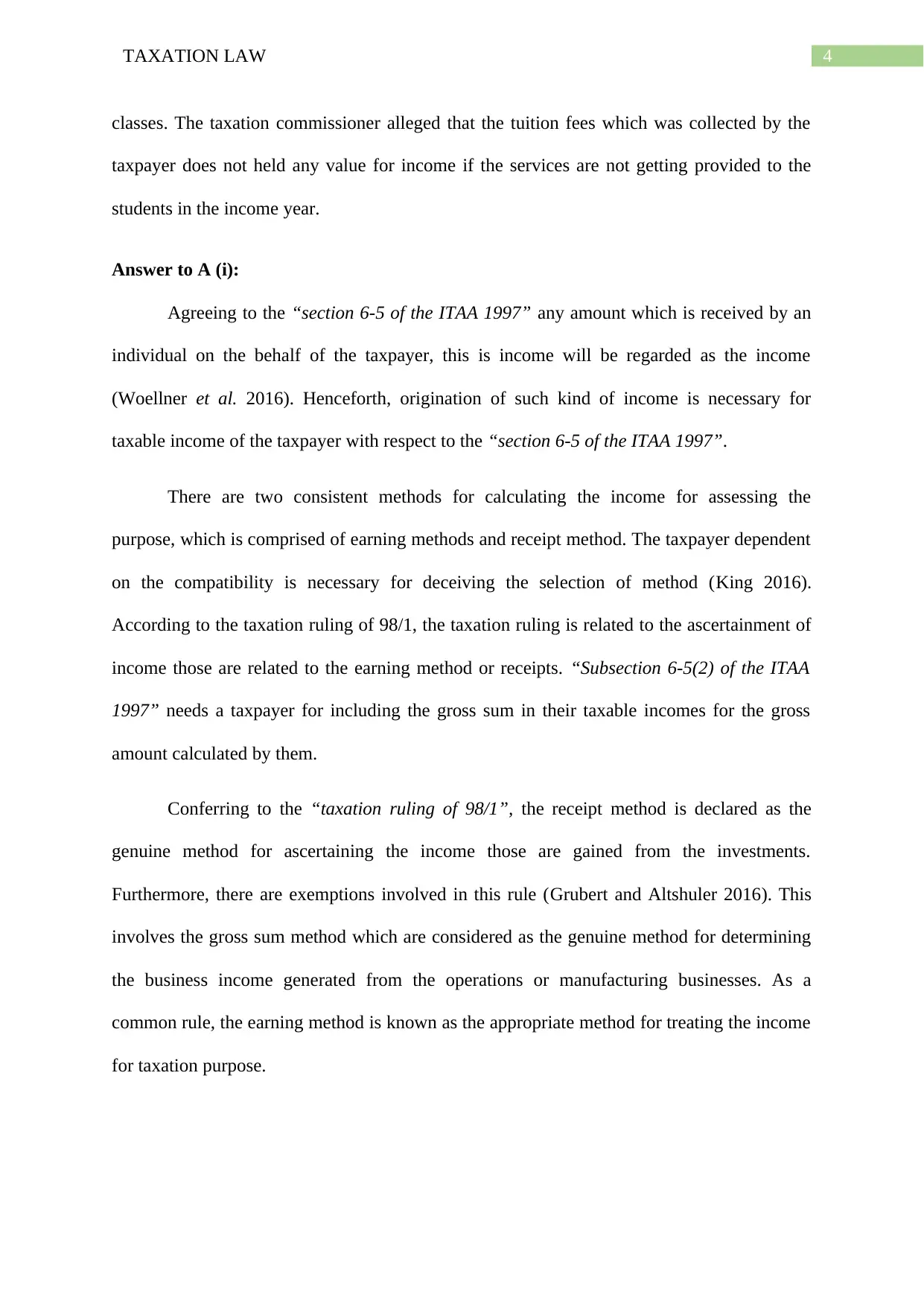
4TAXATION LAW
classes. The taxation commissioner alleged that the tuition fees which was collected by the
taxpayer does not held any value for income if the services are not getting provided to the
students in the income year.
Answer to A (i):
Agreeing to the “section 6-5 of the ITAA 1997” any amount which is received by an
individual on the behalf of the taxpayer, this is income will be regarded as the income
(Woellner et al. 2016). Henceforth, origination of such kind of income is necessary for
taxable income of the taxpayer with respect to the “section 6-5 of the ITAA 1997”.
There are two consistent methods for calculating the income for assessing the
purpose, which is comprised of earning methods and receipt method. The taxpayer dependent
on the compatibility is necessary for deceiving the selection of method (King 2016).
According to the taxation ruling of 98/1, the taxation ruling is related to the ascertainment of
income those are related to the earning method or receipts. “Subsection 6-5(2) of the ITAA
1997” needs a taxpayer for including the gross sum in their taxable incomes for the gross
amount calculated by them.
Conferring to the “taxation ruling of 98/1”, the receipt method is declared as the
genuine method for ascertaining the income those are gained from the investments.
Furthermore, there are exemptions involved in this rule (Grubert and Altshuler 2016). This
involves the gross sum method which are considered as the genuine method for determining
the business income generated from the operations or manufacturing businesses. As a
common rule, the earning method is known as the appropriate method for treating the income
for taxation purpose.
classes. The taxation commissioner alleged that the tuition fees which was collected by the
taxpayer does not held any value for income if the services are not getting provided to the
students in the income year.
Answer to A (i):
Agreeing to the “section 6-5 of the ITAA 1997” any amount which is received by an
individual on the behalf of the taxpayer, this is income will be regarded as the income
(Woellner et al. 2016). Henceforth, origination of such kind of income is necessary for
taxable income of the taxpayer with respect to the “section 6-5 of the ITAA 1997”.
There are two consistent methods for calculating the income for assessing the
purpose, which is comprised of earning methods and receipt method. The taxpayer dependent
on the compatibility is necessary for deceiving the selection of method (King 2016).
According to the taxation ruling of 98/1, the taxation ruling is related to the ascertainment of
income those are related to the earning method or receipts. “Subsection 6-5(2) of the ITAA
1997” needs a taxpayer for including the gross sum in their taxable incomes for the gross
amount calculated by them.
Conferring to the “taxation ruling of 98/1”, the receipt method is declared as the
genuine method for ascertaining the income those are gained from the investments.
Furthermore, there are exemptions involved in this rule (Grubert and Altshuler 2016). This
involves the gross sum method which are considered as the genuine method for determining
the business income generated from the operations or manufacturing businesses. As a
common rule, the earning method is known as the appropriate method for treating the income
for taxation purpose.
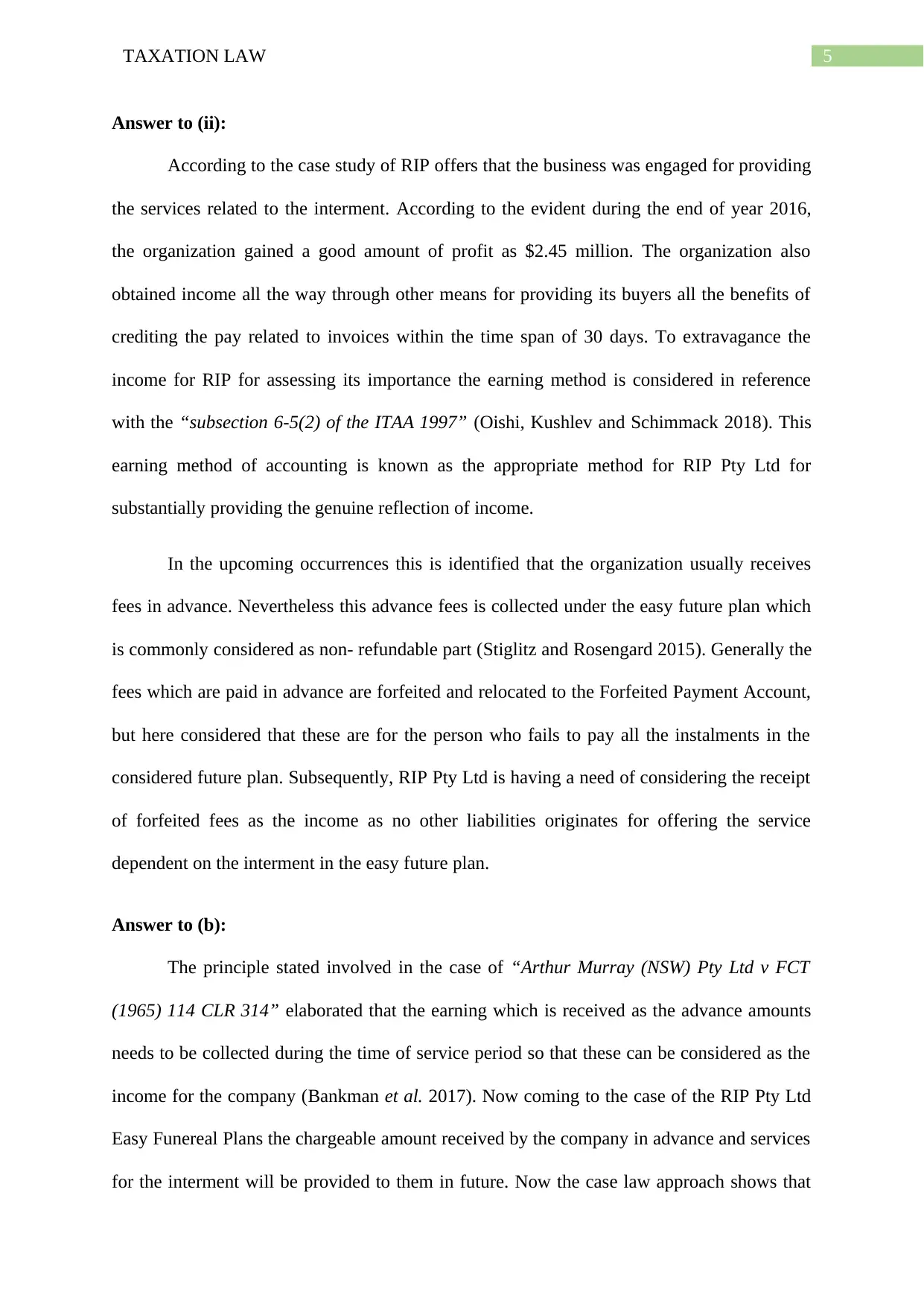
5TAXATION LAW
Answer to (ii):
According to the case study of RIP offers that the business was engaged for providing
the services related to the interment. According to the evident during the end of year 2016,
the organization gained a good amount of profit as $2.45 million. The organization also
obtained income all the way through other means for providing its buyers all the benefits of
crediting the pay related to invoices within the time span of 30 days. To extravagance the
income for RIP for assessing its importance the earning method is considered in reference
with the “subsection 6-5(2) of the ITAA 1997” (Oishi, Kushlev and Schimmack 2018). This
earning method of accounting is known as the appropriate method for RIP Pty Ltd for
substantially providing the genuine reflection of income.
In the upcoming occurrences this is identified that the organization usually receives
fees in advance. Nevertheless this advance fees is collected under the easy future plan which
is commonly considered as non- refundable part (Stiglitz and Rosengard 2015). Generally the
fees which are paid in advance are forfeited and relocated to the Forfeited Payment Account,
but here considered that these are for the person who fails to pay all the instalments in the
considered future plan. Subsequently, RIP Pty Ltd is having a need of considering the receipt
of forfeited fees as the income as no other liabilities originates for offering the service
dependent on the interment in the easy future plan.
Answer to (b):
The principle stated involved in the case of “Arthur Murray (NSW) Pty Ltd v FCT
(1965) 114 CLR 314” elaborated that the earning which is received as the advance amounts
needs to be collected during the time of service period so that these can be considered as the
income for the company (Bankman et al. 2017). Now coming to the case of the RIP Pty Ltd
Easy Funereal Plans the chargeable amount received by the company in advance and services
for the interment will be provided to them in future. Now the case law approach shows that
Answer to (ii):
According to the case study of RIP offers that the business was engaged for providing
the services related to the interment. According to the evident during the end of year 2016,
the organization gained a good amount of profit as $2.45 million. The organization also
obtained income all the way through other means for providing its buyers all the benefits of
crediting the pay related to invoices within the time span of 30 days. To extravagance the
income for RIP for assessing its importance the earning method is considered in reference
with the “subsection 6-5(2) of the ITAA 1997” (Oishi, Kushlev and Schimmack 2018). This
earning method of accounting is known as the appropriate method for RIP Pty Ltd for
substantially providing the genuine reflection of income.
In the upcoming occurrences this is identified that the organization usually receives
fees in advance. Nevertheless this advance fees is collected under the easy future plan which
is commonly considered as non- refundable part (Stiglitz and Rosengard 2015). Generally the
fees which are paid in advance are forfeited and relocated to the Forfeited Payment Account,
but here considered that these are for the person who fails to pay all the instalments in the
considered future plan. Subsequently, RIP Pty Ltd is having a need of considering the receipt
of forfeited fees as the income as no other liabilities originates for offering the service
dependent on the interment in the easy future plan.
Answer to (b):
The principle stated involved in the case of “Arthur Murray (NSW) Pty Ltd v FCT
(1965) 114 CLR 314” elaborated that the earning which is received as the advance amounts
needs to be collected during the time of service period so that these can be considered as the
income for the company (Bankman et al. 2017). Now coming to the case of the RIP Pty Ltd
Easy Funereal Plans the chargeable amount received by the company in advance and services
for the interment will be provided to them in future. Now the case law approach shows that
⊘ This is a preview!⊘
Do you want full access?
Subscribe today to unlock all pages.

Trusted by 1+ million students worldwide
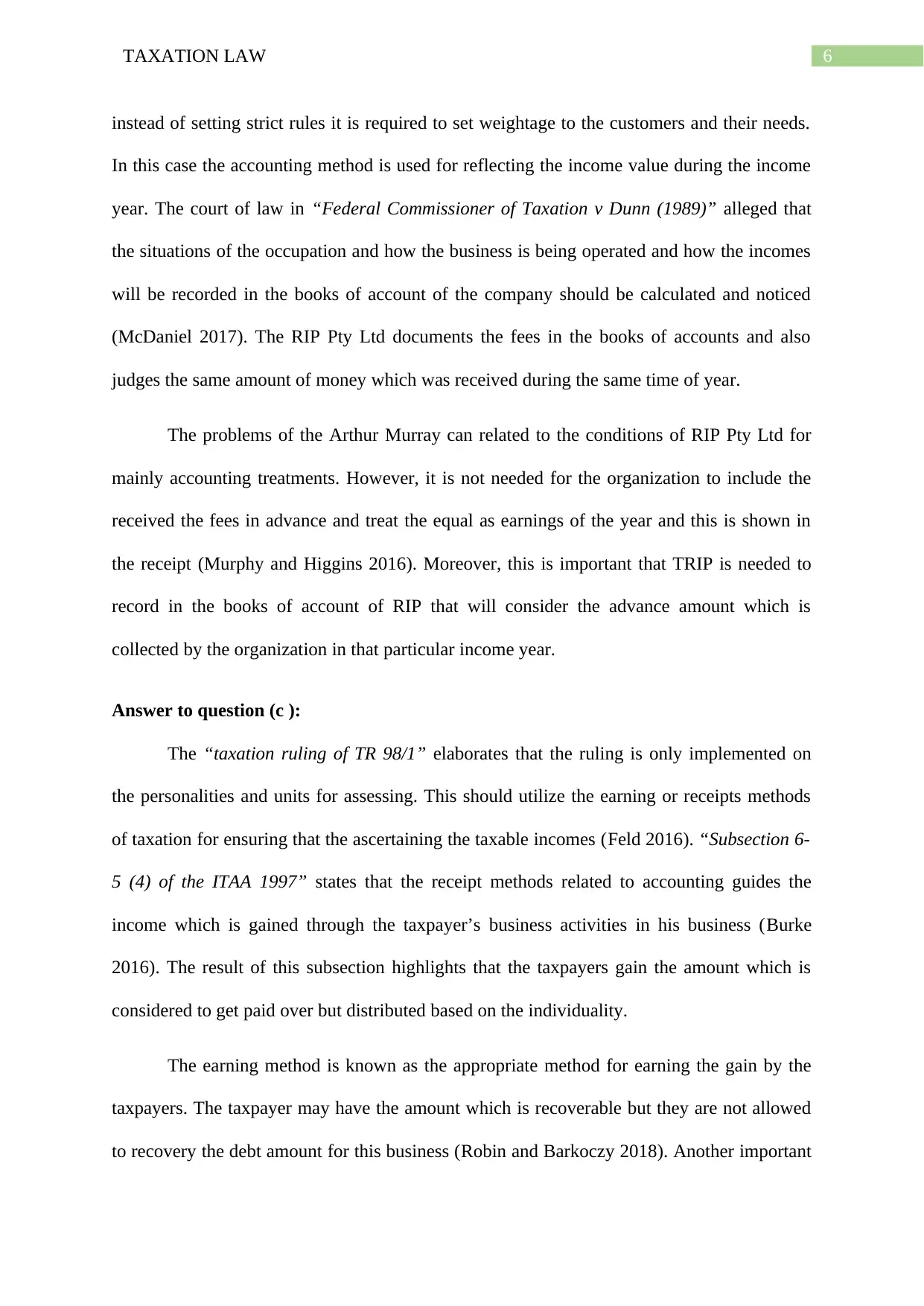
6TAXATION LAW
instead of setting strict rules it is required to set weightage to the customers and their needs.
In this case the accounting method is used for reflecting the income value during the income
year. The court of law in “Federal Commissioner of Taxation v Dunn (1989)” alleged that
the situations of the occupation and how the business is being operated and how the incomes
will be recorded in the books of account of the company should be calculated and noticed
(McDaniel 2017). The RIP Pty Ltd documents the fees in the books of accounts and also
judges the same amount of money which was received during the same time of year.
The problems of the Arthur Murray can related to the conditions of RIP Pty Ltd for
mainly accounting treatments. However, it is not needed for the organization to include the
received the fees in advance and treat the equal as earnings of the year and this is shown in
the receipt (Murphy and Higgins 2016). Moreover, this is important that TRIP is needed to
record in the books of account of RIP that will consider the advance amount which is
collected by the organization in that particular income year.
Answer to question (c ):
The “taxation ruling of TR 98/1” elaborates that the ruling is only implemented on
the personalities and units for assessing. This should utilize the earning or receipts methods
of taxation for ensuring that the ascertaining the taxable incomes (Feld 2016). “Subsection 6-
5 (4) of the ITAA 1997” states that the receipt methods related to accounting guides the
income which is gained through the taxpayer’s business activities in his business (Burke
2016). The result of this subsection highlights that the taxpayers gain the amount which is
considered to get paid over but distributed based on the individuality.
The earning method is known as the appropriate method for earning the gain by the
taxpayers. The taxpayer may have the amount which is recoverable but they are not allowed
to recovery the debt amount for this business (Robin and Barkoczy 2018). Another important
instead of setting strict rules it is required to set weightage to the customers and their needs.
In this case the accounting method is used for reflecting the income value during the income
year. The court of law in “Federal Commissioner of Taxation v Dunn (1989)” alleged that
the situations of the occupation and how the business is being operated and how the incomes
will be recorded in the books of account of the company should be calculated and noticed
(McDaniel 2017). The RIP Pty Ltd documents the fees in the books of accounts and also
judges the same amount of money which was received during the same time of year.
The problems of the Arthur Murray can related to the conditions of RIP Pty Ltd for
mainly accounting treatments. However, it is not needed for the organization to include the
received the fees in advance and treat the equal as earnings of the year and this is shown in
the receipt (Murphy and Higgins 2016). Moreover, this is important that TRIP is needed to
record in the books of account of RIP that will consider the advance amount which is
collected by the organization in that particular income year.
Answer to question (c ):
The “taxation ruling of TR 98/1” elaborates that the ruling is only implemented on
the personalities and units for assessing. This should utilize the earning or receipts methods
of taxation for ensuring that the ascertaining the taxable incomes (Feld 2016). “Subsection 6-
5 (4) of the ITAA 1997” states that the receipt methods related to accounting guides the
income which is gained through the taxpayer’s business activities in his business (Burke
2016). The result of this subsection highlights that the taxpayers gain the amount which is
considered to get paid over but distributed based on the individuality.
The earning method is known as the appropriate method for earning the gain by the
taxpayers. The taxpayer may have the amount which is recoverable but they are not allowed
to recovery the debt amount for this business (Robin and Barkoczy 2018). Another important
Paraphrase This Document
Need a fresh take? Get an instant paraphrase of this document with our AI Paraphraser
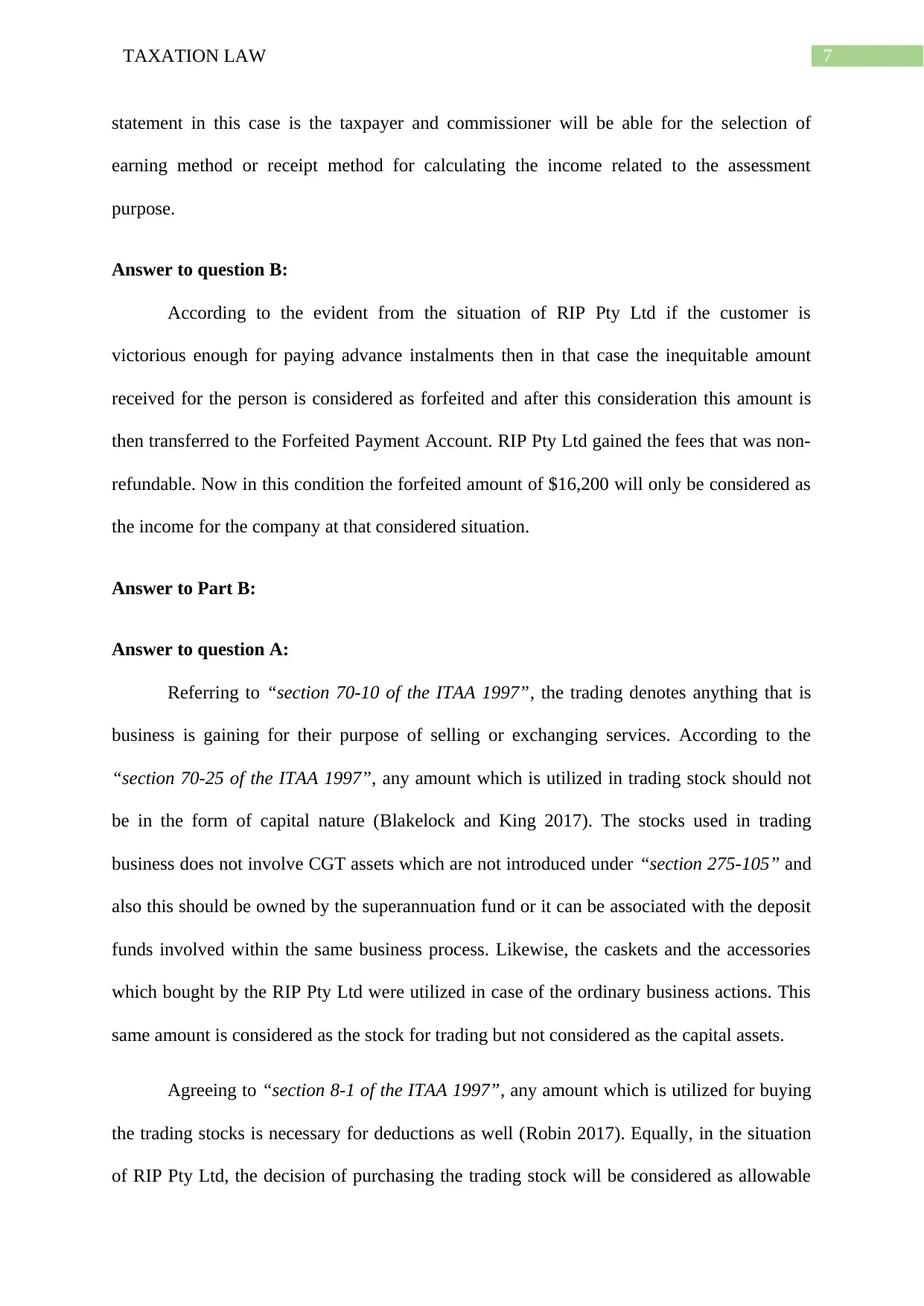
7TAXATION LAW
statement in this case is the taxpayer and commissioner will be able for the selection of
earning method or receipt method for calculating the income related to the assessment
purpose.
Answer to question B:
According to the evident from the situation of RIP Pty Ltd if the customer is
victorious enough for paying advance instalments then in that case the inequitable amount
received for the person is considered as forfeited and after this consideration this amount is
then transferred to the Forfeited Payment Account. RIP Pty Ltd gained the fees that was non-
refundable. Now in this condition the forfeited amount of $16,200 will only be considered as
the income for the company at that considered situation.
Answer to Part B:
Answer to question A:
Referring to “section 70-10 of the ITAA 1997”, the trading denotes anything that is
business is gaining for their purpose of selling or exchanging services. According to the
“section 70-25 of the ITAA 1997”, any amount which is utilized in trading stock should not
be in the form of capital nature (Blakelock and King 2017). The stocks used in trading
business does not involve CGT assets which are not introduced under “section 275-105” and
also this should be owned by the superannuation fund or it can be associated with the deposit
funds involved within the same business process. Likewise, the caskets and the accessories
which bought by the RIP Pty Ltd were utilized in case of the ordinary business actions. This
same amount is considered as the stock for trading but not considered as the capital assets.
Agreeing to “section 8-1 of the ITAA 1997”, any amount which is utilized for buying
the trading stocks is necessary for deductions as well (Robin 2017). Equally, in the situation
of RIP Pty Ltd, the decision of purchasing the trading stock will be considered as allowable
statement in this case is the taxpayer and commissioner will be able for the selection of
earning method or receipt method for calculating the income related to the assessment
purpose.
Answer to question B:
According to the evident from the situation of RIP Pty Ltd if the customer is
victorious enough for paying advance instalments then in that case the inequitable amount
received for the person is considered as forfeited and after this consideration this amount is
then transferred to the Forfeited Payment Account. RIP Pty Ltd gained the fees that was non-
refundable. Now in this condition the forfeited amount of $16,200 will only be considered as
the income for the company at that considered situation.
Answer to Part B:
Answer to question A:
Referring to “section 70-10 of the ITAA 1997”, the trading denotes anything that is
business is gaining for their purpose of selling or exchanging services. According to the
“section 70-25 of the ITAA 1997”, any amount which is utilized in trading stock should not
be in the form of capital nature (Blakelock and King 2017). The stocks used in trading
business does not involve CGT assets which are not introduced under “section 275-105” and
also this should be owned by the superannuation fund or it can be associated with the deposit
funds involved within the same business process. Likewise, the caskets and the accessories
which bought by the RIP Pty Ltd were utilized in case of the ordinary business actions. This
same amount is considered as the stock for trading but not considered as the capital assets.
Agreeing to “section 8-1 of the ITAA 1997”, any amount which is utilized for buying
the trading stocks is necessary for deductions as well (Robin 2017). Equally, in the situation
of RIP Pty Ltd, the decision of purchasing the trading stock will be considered as allowable
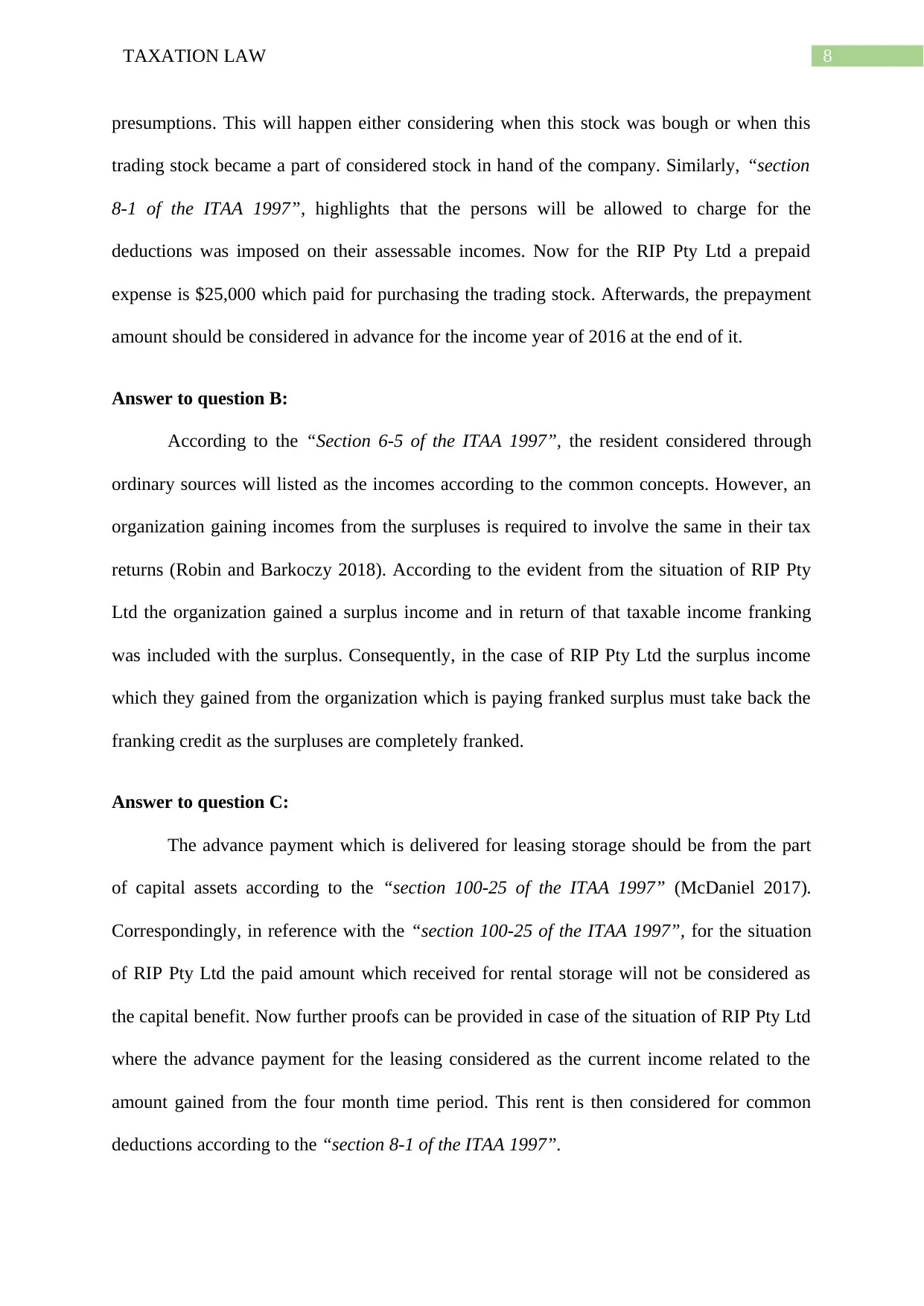
8TAXATION LAW
presumptions. This will happen either considering when this stock was bough or when this
trading stock became a part of considered stock in hand of the company. Similarly, “section
8-1 of the ITAA 1997”, highlights that the persons will be allowed to charge for the
deductions was imposed on their assessable incomes. Now for the RIP Pty Ltd a prepaid
expense is $25,000 which paid for purchasing the trading stock. Afterwards, the prepayment
amount should be considered in advance for the income year of 2016 at the end of it.
Answer to question B:
According to the “Section 6-5 of the ITAA 1997”, the resident considered through
ordinary sources will listed as the incomes according to the common concepts. However, an
organization gaining incomes from the surpluses is required to involve the same in their tax
returns (Robin and Barkoczy 2018). According to the evident from the situation of RIP Pty
Ltd the organization gained a surplus income and in return of that taxable income franking
was included with the surplus. Consequently, in the case of RIP Pty Ltd the surplus income
which they gained from the organization which is paying franked surplus must take back the
franking credit as the surpluses are completely franked.
Answer to question C:
The advance payment which is delivered for leasing storage should be from the part
of capital assets according to the “section 100-25 of the ITAA 1997” (McDaniel 2017).
Correspondingly, in reference with the “section 100-25 of the ITAA 1997”, for the situation
of RIP Pty Ltd the paid amount which received for rental storage will not be considered as
the capital benefit. Now further proofs can be provided in case of the situation of RIP Pty Ltd
where the advance payment for the leasing considered as the current income related to the
amount gained from the four month time period. This rent is then considered for common
deductions according to the “section 8-1 of the ITAA 1997”.
presumptions. This will happen either considering when this stock was bough or when this
trading stock became a part of considered stock in hand of the company. Similarly, “section
8-1 of the ITAA 1997”, highlights that the persons will be allowed to charge for the
deductions was imposed on their assessable incomes. Now for the RIP Pty Ltd a prepaid
expense is $25,000 which paid for purchasing the trading stock. Afterwards, the prepayment
amount should be considered in advance for the income year of 2016 at the end of it.
Answer to question B:
According to the “Section 6-5 of the ITAA 1997”, the resident considered through
ordinary sources will listed as the incomes according to the common concepts. However, an
organization gaining incomes from the surpluses is required to involve the same in their tax
returns (Robin and Barkoczy 2018). According to the evident from the situation of RIP Pty
Ltd the organization gained a surplus income and in return of that taxable income franking
was included with the surplus. Consequently, in the case of RIP Pty Ltd the surplus income
which they gained from the organization which is paying franked surplus must take back the
franking credit as the surpluses are completely franked.
Answer to question C:
The advance payment which is delivered for leasing storage should be from the part
of capital assets according to the “section 100-25 of the ITAA 1997” (McDaniel 2017).
Correspondingly, in reference with the “section 100-25 of the ITAA 1997”, for the situation
of RIP Pty Ltd the paid amount which received for rental storage will not be considered as
the capital benefit. Now further proofs can be provided in case of the situation of RIP Pty Ltd
where the advance payment for the leasing considered as the current income related to the
amount gained from the four month time period. This rent is then considered for common
deductions according to the “section 8-1 of the ITAA 1997”.
⊘ This is a preview!⊘
Do you want full access?
Subscribe today to unlock all pages.

Trusted by 1+ million students worldwide
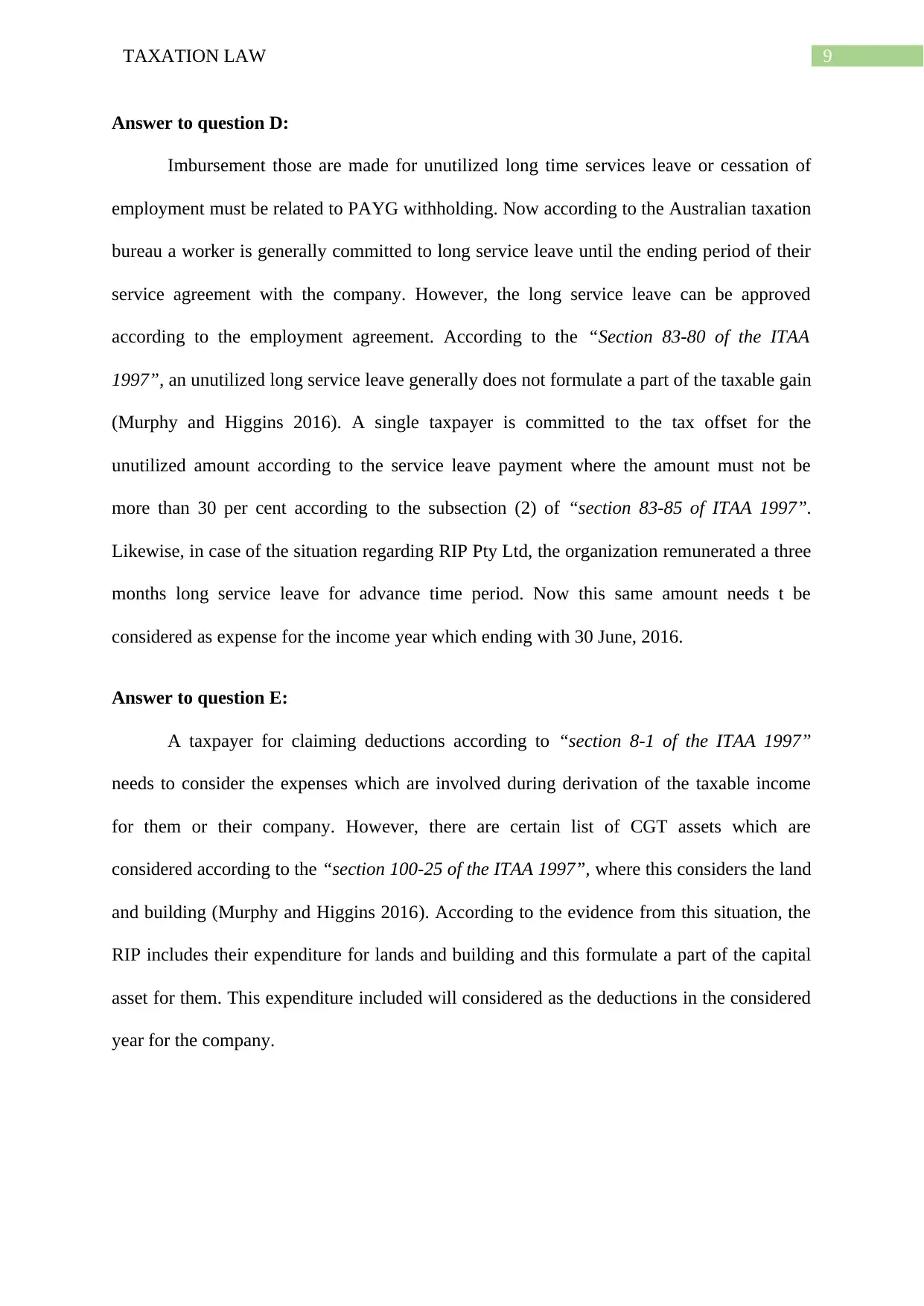
9TAXATION LAW
Answer to question D:
Imbursement those are made for unutilized long time services leave or cessation of
employment must be related to PAYG withholding. Now according to the Australian taxation
bureau a worker is generally committed to long service leave until the ending period of their
service agreement with the company. However, the long service leave can be approved
according to the employment agreement. According to the “Section 83-80 of the ITAA
1997”, an unutilized long service leave generally does not formulate a part of the taxable gain
(Murphy and Higgins 2016). A single taxpayer is committed to the tax offset for the
unutilized amount according to the service leave payment where the amount must not be
more than 30 per cent according to the subsection (2) of “section 83-85 of ITAA 1997”.
Likewise, in case of the situation regarding RIP Pty Ltd, the organization remunerated a three
months long service leave for advance time period. Now this same amount needs t be
considered as expense for the income year which ending with 30 June, 2016.
Answer to question E:
A taxpayer for claiming deductions according to “section 8-1 of the ITAA 1997”
needs to consider the expenses which are involved during derivation of the taxable income
for them or their company. However, there are certain list of CGT assets which are
considered according to the “section 100-25 of the ITAA 1997”, where this considers the land
and building (Murphy and Higgins 2016). According to the evidence from this situation, the
RIP includes their expenditure for lands and building and this formulate a part of the capital
asset for them. This expenditure included will considered as the deductions in the considered
year for the company.
Answer to question D:
Imbursement those are made for unutilized long time services leave or cessation of
employment must be related to PAYG withholding. Now according to the Australian taxation
bureau a worker is generally committed to long service leave until the ending period of their
service agreement with the company. However, the long service leave can be approved
according to the employment agreement. According to the “Section 83-80 of the ITAA
1997”, an unutilized long service leave generally does not formulate a part of the taxable gain
(Murphy and Higgins 2016). A single taxpayer is committed to the tax offset for the
unutilized amount according to the service leave payment where the amount must not be
more than 30 per cent according to the subsection (2) of “section 83-85 of ITAA 1997”.
Likewise, in case of the situation regarding RIP Pty Ltd, the organization remunerated a three
months long service leave for advance time period. Now this same amount needs t be
considered as expense for the income year which ending with 30 June, 2016.
Answer to question E:
A taxpayer for claiming deductions according to “section 8-1 of the ITAA 1997”
needs to consider the expenses which are involved during derivation of the taxable income
for them or their company. However, there are certain list of CGT assets which are
considered according to the “section 100-25 of the ITAA 1997”, where this considers the land
and building (Murphy and Higgins 2016). According to the evidence from this situation, the
RIP includes their expenditure for lands and building and this formulate a part of the capital
asset for them. This expenditure included will considered as the deductions in the considered
year for the company.
Paraphrase This Document
Need a fresh take? Get an instant paraphrase of this document with our AI Paraphraser
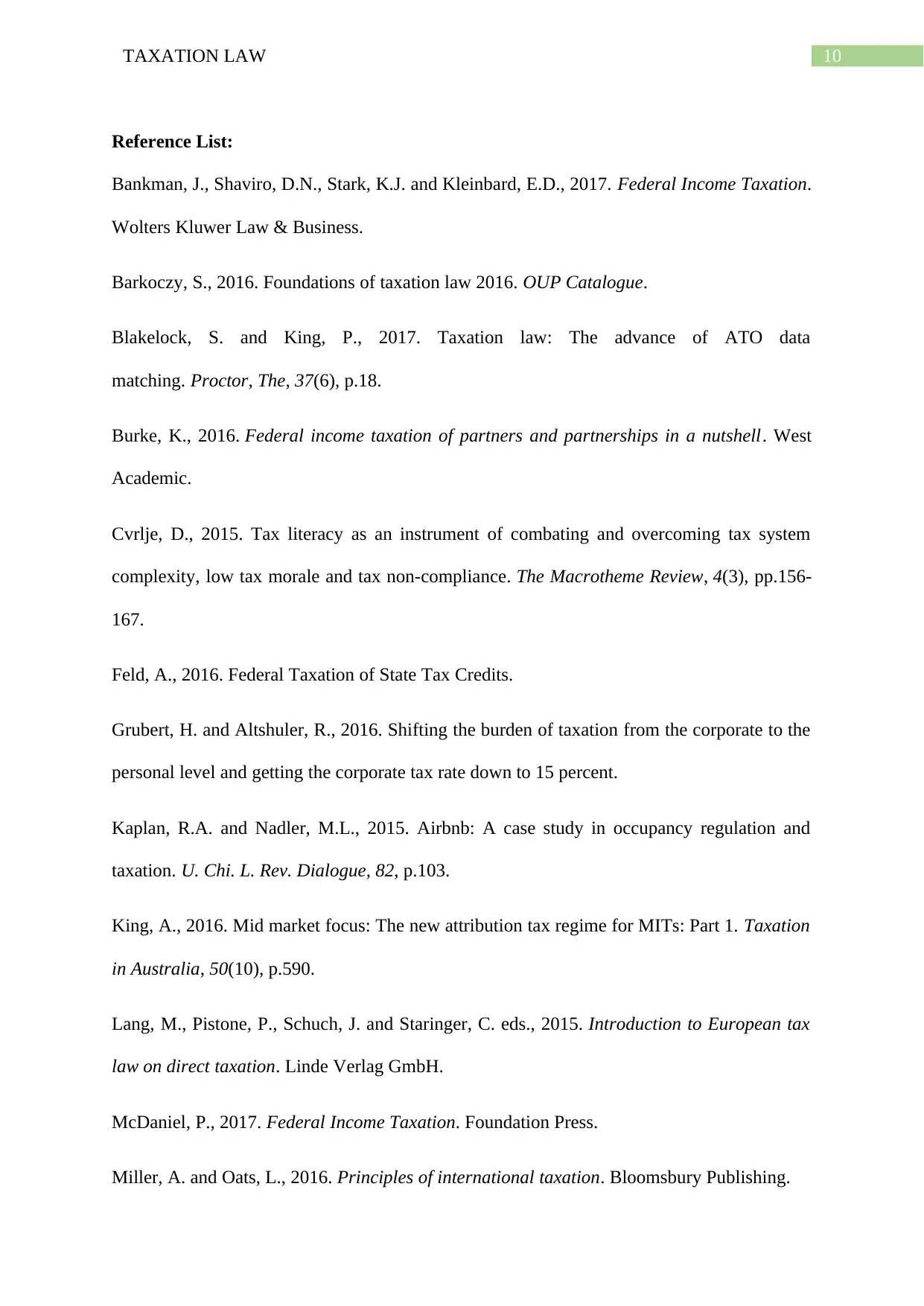
10TAXATION LAW
Reference List:
Bankman, J., Shaviro, D.N., Stark, K.J. and Kleinbard, E.D., 2017. Federal Income Taxation.
Wolters Kluwer Law & Business.
Barkoczy, S., 2016. Foundations of taxation law 2016. OUP Catalogue.
Blakelock, S. and King, P., 2017. Taxation law: The advance of ATO data
matching. Proctor, The, 37(6), p.18.
Burke, K., 2016. Federal income taxation of partners and partnerships in a nutshell. West
Academic.
Cvrlje, D., 2015. Tax literacy as an instrument of combating and overcoming tax system
complexity, low tax morale and tax non-compliance. The Macrotheme Review, 4(3), pp.156-
167.
Feld, A., 2016. Federal Taxation of State Tax Credits.
Grubert, H. and Altshuler, R., 2016. Shifting the burden of taxation from the corporate to the
personal level and getting the corporate tax rate down to 15 percent.
Kaplan, R.A. and Nadler, M.L., 2015. Airbnb: A case study in occupancy regulation and
taxation. U. Chi. L. Rev. Dialogue, 82, p.103.
King, A., 2016. Mid market focus: The new attribution tax regime for MITs: Part 1. Taxation
in Australia, 50(10), p.590.
Lang, M., Pistone, P., Schuch, J. and Staringer, C. eds., 2015. Introduction to European tax
law on direct taxation. Linde Verlag GmbH.
McDaniel, P., 2017. Federal Income Taxation. Foundation Press.
Miller, A. and Oats, L., 2016. Principles of international taxation. Bloomsbury Publishing.
Reference List:
Bankman, J., Shaviro, D.N., Stark, K.J. and Kleinbard, E.D., 2017. Federal Income Taxation.
Wolters Kluwer Law & Business.
Barkoczy, S., 2016. Foundations of taxation law 2016. OUP Catalogue.
Blakelock, S. and King, P., 2017. Taxation law: The advance of ATO data
matching. Proctor, The, 37(6), p.18.
Burke, K., 2016. Federal income taxation of partners and partnerships in a nutshell. West
Academic.
Cvrlje, D., 2015. Tax literacy as an instrument of combating and overcoming tax system
complexity, low tax morale and tax non-compliance. The Macrotheme Review, 4(3), pp.156-
167.
Feld, A., 2016. Federal Taxation of State Tax Credits.
Grubert, H. and Altshuler, R., 2016. Shifting the burden of taxation from the corporate to the
personal level and getting the corporate tax rate down to 15 percent.
Kaplan, R.A. and Nadler, M.L., 2015. Airbnb: A case study in occupancy regulation and
taxation. U. Chi. L. Rev. Dialogue, 82, p.103.
King, A., 2016. Mid market focus: The new attribution tax regime for MITs: Part 1. Taxation
in Australia, 50(10), p.590.
Lang, M., Pistone, P., Schuch, J. and Staringer, C. eds., 2015. Introduction to European tax
law on direct taxation. Linde Verlag GmbH.
McDaniel, P., 2017. Federal Income Taxation. Foundation Press.
Miller, A. and Oats, L., 2016. Principles of international taxation. Bloomsbury Publishing.
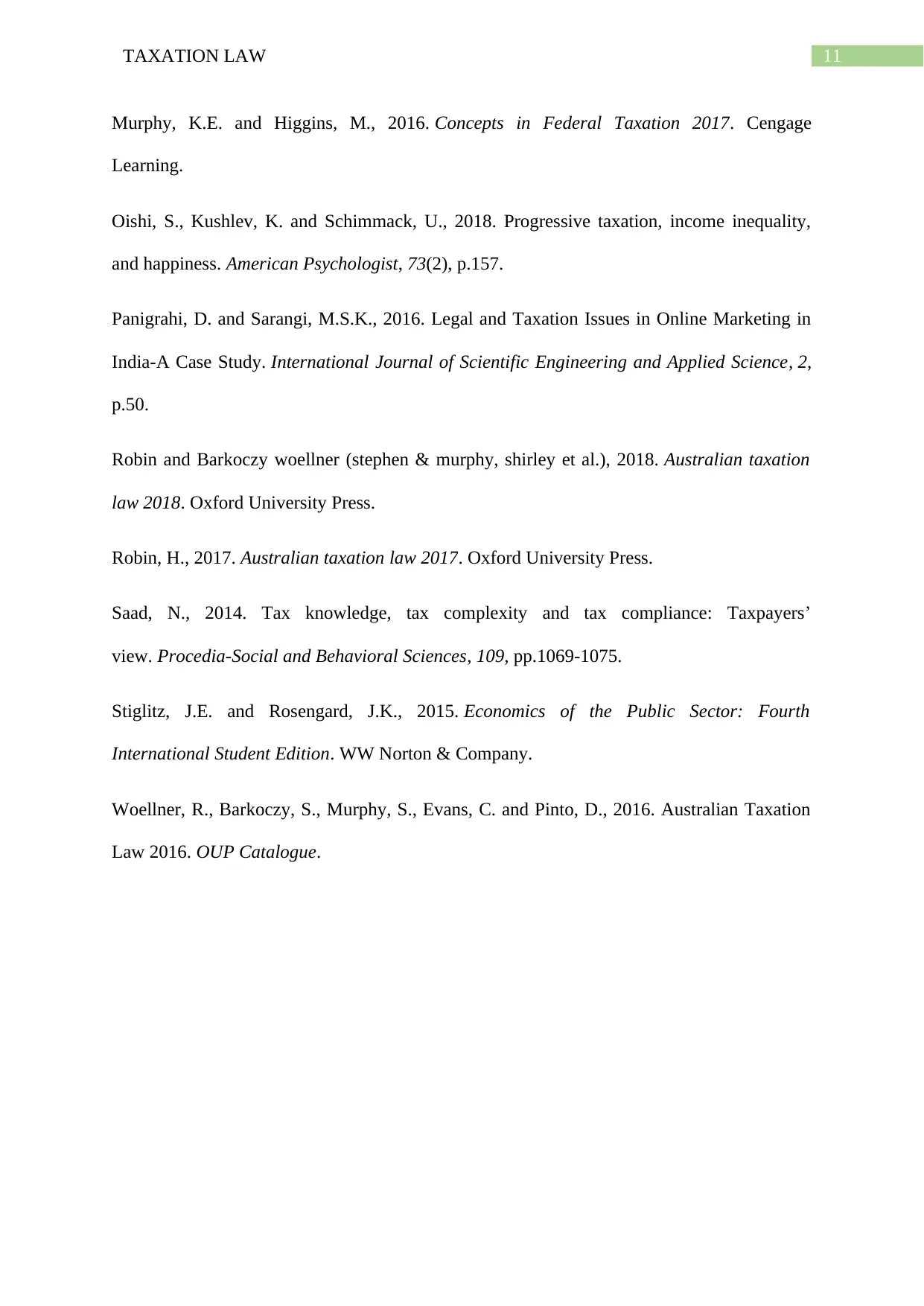
11TAXATION LAW
Murphy, K.E. and Higgins, M., 2016. Concepts in Federal Taxation 2017. Cengage
Learning.
Oishi, S., Kushlev, K. and Schimmack, U., 2018. Progressive taxation, income inequality,
and happiness. American Psychologist, 73(2), p.157.
Panigrahi, D. and Sarangi, M.S.K., 2016. Legal and Taxation Issues in Online Marketing in
India-A Case Study. International Journal of Scientific Engineering and Applied Science, 2,
p.50.
Robin and Barkoczy woellner (stephen & murphy, shirley et al.), 2018. Australian taxation
law 2018. Oxford University Press.
Robin, H., 2017. Australian taxation law 2017. Oxford University Press.
Saad, N., 2014. Tax knowledge, tax complexity and tax compliance: Taxpayers’
view. Procedia-Social and Behavioral Sciences, 109, pp.1069-1075.
Stiglitz, J.E. and Rosengard, J.K., 2015. Economics of the Public Sector: Fourth
International Student Edition. WW Norton & Company.
Woellner, R., Barkoczy, S., Murphy, S., Evans, C. and Pinto, D., 2016. Australian Taxation
Law 2016. OUP Catalogue.
Murphy, K.E. and Higgins, M., 2016. Concepts in Federal Taxation 2017. Cengage
Learning.
Oishi, S., Kushlev, K. and Schimmack, U., 2018. Progressive taxation, income inequality,
and happiness. American Psychologist, 73(2), p.157.
Panigrahi, D. and Sarangi, M.S.K., 2016. Legal and Taxation Issues in Online Marketing in
India-A Case Study. International Journal of Scientific Engineering and Applied Science, 2,
p.50.
Robin and Barkoczy woellner (stephen & murphy, shirley et al.), 2018. Australian taxation
law 2018. Oxford University Press.
Robin, H., 2017. Australian taxation law 2017. Oxford University Press.
Saad, N., 2014. Tax knowledge, tax complexity and tax compliance: Taxpayers’
view. Procedia-Social and Behavioral Sciences, 109, pp.1069-1075.
Stiglitz, J.E. and Rosengard, J.K., 2015. Economics of the Public Sector: Fourth
International Student Edition. WW Norton & Company.
Woellner, R., Barkoczy, S., Murphy, S., Evans, C. and Pinto, D., 2016. Australian Taxation
Law 2016. OUP Catalogue.
⊘ This is a preview!⊘
Do you want full access?
Subscribe today to unlock all pages.

Trusted by 1+ million students worldwide
1 out of 12
Related Documents
Your All-in-One AI-Powered Toolkit for Academic Success.
+13062052269
info@desklib.com
Available 24*7 on WhatsApp / Email
![[object Object]](/_next/static/media/star-bottom.7253800d.svg)
Unlock your academic potential
Copyright © 2020–2025 A2Z Services. All Rights Reserved. Developed and managed by ZUCOL.





